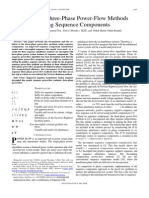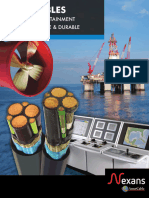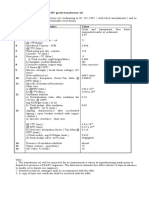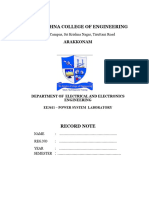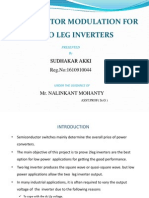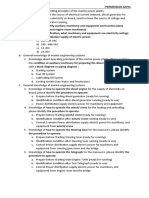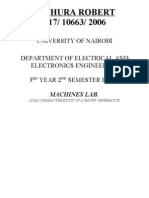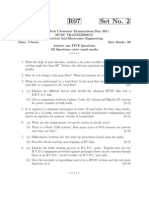Line Parameters Computation
Uploaded by
swathi_grenLine Parameters Computation
Uploaded by
swathi_grenEX.
NO :1 DATE : COMPUTATION OF PARAMETERS AND NES
MODELLING OF TRANSMISSION LI
Aim: (i) To determine the positive sequence line parameters L and C per phase /km of a 3 phase single and double circuit transmission line for different conductor ar rangements. (ii) To understand modeling and performance of medium lines. Software required: MATLAB Procedure: 1. Enter the command window of the MAT LAB. 2. Create a new M file by selecting file New M- File. 3. Type and save the program in the editor window 4. Execute the program by pressing tools run. 5. View the result. Theory: Transmission line has four parameters namely resistance, inductance, cap acitance and conductance. The inductance and capacitance are due to the effect o f magnetic and electric fields around the conductor. The resistance of the condu ctor is best determined from the manufacturers data, the inductance and the capa citance can be evaluated using the formula. Problem: A 3 phase over head line 200km long r=0.16/km & conductor diameter of 2cm wi th spacings 4,5,6 transposed. Find A, B, C, D constants sending end voltage, cur rents, power factor & power when the line is delivering full load of 50MW at 132 KV, 0.8 pf(lag), transmission efficiency, receiving end voltage & regulation. Inductance: General formula L= 0.2ln(Dm/Ds) Where Dm = geometric mean distance (GMD). Ds = geometric mean radius (GMR) I. Single phase 2 wire system: GMD =D GMR = Where r= radius of the conductor. II. Three phase symmetrical spacing: GMD =D GMR = Where r= radius of the conductor III. Three phase asymmetrical transposed: GMD = geometric mean of the 3 distance of symmetrically placed conductors. = GMR = Where r= radius of the conductor Composite conductor lines: The inductance of composite conductor X is given by,Lx = 0.2ln(GMD/GMR) Where, GMD = GMR = Where
Bundled conductors: The GMR of bundled conductor is normally calculated, GMR of 2 sub-conductor, c= (Ds*d)1/2 GMR of 3 sub conductors, GMR of 4 sub conductors, Where, Ds is the GMR of each sub-conductor. d is bundle spacing. Phase double circuit transposed: The inductance per phase in milli henries per km is L= 0.2ln(GMD/GMRL) mH/km Where, GMRL is the equivalent geometric mean radius and is given by GMRL = (DSADSBDSC)1/3. Where, DSA, DSB and DSC are GMR of each phase group and given by DSA = DSB = DSC = Where, = GMR of bundled conductor if conductor a1,a2,..are bundled conductors. Dsb=ra1'=rb1=ra'2=ra'2=rb'2=rc'2 if a1,a2..are bundled conductors GMD is the equivalent GMD per phase and is given by GMD=[DAB*DBC*DCA]1/3 Where, DAB,DBC&DCA are GMD between each phase group A-B,B-C,C-A which are given by DAB=[Da1b1*Da1b2*Da2b1*Da2b2]1/4 DBC=[Db1c1*Db1c2*Db2c1*Db2c2]1/4 DCA=[Dc1a1*Dc2a1*Dc2a1*Dc2a2]1/4 Capacitance: A general formula for evaluating capacitance per phase in micro farad / km of a transmission line is given by,C= 0.0556/ln(GMD/GMR) F/km. Where, GMD is the geometric mean distance which is same as the defined for induc tance under various cases. Program: ab=input(Value of ab: ); bc=input(Value of bc: ); ca=input(Value of ca: ); pr=input(Receiving end power in MW: ); vr=input(Receiving end voltage in KV: ); pfr=input(Receiving end power factor: ); l=input(Length of the line in km: ); r=input(Resistance/ph/km: ); f=input(Frequency: ); d=input(Diameter in m: ); rad=d/2; newrad=(0.7788*rad); deq=(ab*bc*ca)^(1/3); L=2*10^(-7)*log(deq/newrad); c=(2*pi*8.854*10^-12)/log(deq/rad); XL=2*pi*f*L*l*1000; rnew=r*l; z=rnew+i*(XL); y=i*(2*pi*f*c*l*1000); A=1+((y*z)/2); D=A; B=z;
C=y*(1+(y*z)/4); vrph=(vr*10^3)/1.732; irold=(pr*10^6)/(1.732*vr*10^3*0.8) k=sin(acos(pfr)); ir=irold*(pfr-(j*k)); vs=((A*vrph)+(B*ir)); is=((C*vrph)+(D*ir)); angle(vs); angle(is); f=angle(vs); u=angle(is); pfs=cos(f-u); eff=((pr*10^6)/(3*abs(vs)*abs(is)*pfs))*100; reg=(((abs(vs)/abs(A))-abs(vrph))/abs(vrph))*100; L c rnew A B C abs(vs) abs(is) angle(vs)*180/pi angle(is)*180/pi pfs eff reg
Output: Value of ab 4 Value of bc 5 Value of ca 6 receiving end power in MW 50 Receiving end voltage 132 Receiving end power factor 0.8 Length of the line in km 200 Resistance/phase/km 0.16 Frequency 50 Diameter in m 0.02 L = 1.2902e-006 C = - 2.5419e-006 + 5.5725e-0041 rnew = 32 A = 0.9772 + 0.00901 B = 32.0000 + 81.06571 C = -2.5419e-006 + 5.5725e-0041 ans = 9.5677e+004 ans = 244.2088 ans = 7.9105 ans = -28.3157 PFS = 0.8607 eff = 88.4248 reg = 28.4694
Result: Thus the program to find the transmission line parameters using MAT LAB was done and executed successfully
You might also like
- Computation of TR Line Parameters & ModellingNo ratings yetComputation of TR Line Parameters & Modelling18 pages
- Technical Information For Motor Protection IPDNo ratings yetTechnical Information For Motor Protection IPD40 pages
- Impedance Calculation of Cables Using Subdivision of The Cable ConductorsNo ratings yetImpedance Calculation of Cables Using Subdivision of The Cable Conductors76 pages
- Improved Three-Phase Power-Flow Methods Using Sequence Components - MA Akher - KM Nor - AHA RashidNo ratings yetImproved Three-Phase Power-Flow Methods Using Sequence Components - MA Akher - KM Nor - AHA Rashid13 pages
- Calculation of Overhead and Underground Cable Parameters at Harmonic FrequenciesNo ratings yetCalculation of Overhead and Underground Cable Parameters at Harmonic Frequencies13 pages
- Analysis of Influential Factors in Determining Very Fast Transient Overvoltages of GIS SubstationsNo ratings yetAnalysis of Influential Factors in Determining Very Fast Transient Overvoltages of GIS Substations6 pages
- Construction and Analysis of Generator Actual Capability Curves Using The New MethodNo ratings yetConstruction and Analysis of Generator Actual Capability Curves Using The New Method11 pages
- Insulation of High-Voltage Equipment: V.Y.UshakovNo ratings yetInsulation of High-Voltage Equipment: V.Y.Ushakov4 pages
- Design Criteria On Substation Protection by Using Instrument TransformersNo ratings yetDesign Criteria On Substation Protection by Using Instrument Transformers6 pages
- Pages From Electrical Transmission and Distribution Reference Book of WestinghouseNo ratings yetPages From Electrical Transmission and Distribution Reference Book of Westinghouse4 pages
- ACSR Some Equal Standards-Indian StandardNo ratings yetACSR Some Equal Standards-Indian Standard20 pages
- Measured Result: y E-Field Cell E-Field CellNo ratings yetMeasured Result: y E-Field Cell E-Field Cell7 pages
- Digsilent Powerfactory: Technical Reference DocumentationNo ratings yetDigsilent Powerfactory: Technical Reference Documentation23 pages
- S11 IEEE IEC ComparisonReport On TransformersNo ratings yetS11 IEEE IEC ComparisonReport On Transformers12 pages
- Experiment-1: AIM Software Required: Matlab 7.6 TheoryNo ratings yetExperiment-1: AIM Software Required: Matlab 7.6 Theory2 pages
- Experiment 1 Computation of Parameters and Modelling of Transmission LinesNo ratings yetExperiment 1 Computation of Parameters and Modelling of Transmission Lines13 pages
- Centers Use Supervisory Control and Data Acquisition' (SCADA), Where The Data IsNo ratings yetCenters Use Supervisory Control and Data Acquisition' (SCADA), Where The Data Is7 pages
- Power Systems Operation and Planning - EEE 577No ratings yetPower Systems Operation and Planning - EEE 57759 pages
- Definition:: Software Program Linked Routines HardwareNo ratings yetDefinition:: Software Program Linked Routines Hardware1 page
- A Dynamic Lithium-Ion Battery Model Considering The Effects of Temperature and Capacity FadingNo ratings yetA Dynamic Lithium-Ion Battery Model Considering The Effects of Temperature and Capacity Fading4 pages
- Protection and Switch Gear - 2 Marks With AnswersNo ratings yetProtection and Switch Gear - 2 Marks With Answers1 page
- STAMFORD AVK DIGITAL AVR, MA330-Wuxi Huaxiang Control Co.,LtdNo ratings yetSTAMFORD AVK DIGITAL AVR, MA330-Wuxi Huaxiang Control Co.,Ltd3 pages
- RECLOSER-FARADAY-33KV Auto Recloser BrochureNo ratings yetRECLOSER-FARADAY-33KV Auto Recloser Brochure9 pages
- Tugas 1 Permesinan Kapal (D.iii Nautika)No ratings yetTugas 1 Permesinan Kapal (D.iii Nautika)1 page
- Technical Service Bulletin 17B0001N01 PDFNo ratings yetTechnical Service Bulletin 17B0001N01 PDF2 pages
- Load Characteristics of A Shunt GeneratorNo ratings yetLoad Characteristics of A Shunt Generator6 pages
- Electricity Tariff: Definition: The Amount of Money Frame by TheNo ratings yetElectricity Tariff: Definition: The Amount of Money Frame by The15 pages
- Monitoring Technique: Thermistor Motor Protection Relay Ba 9038, Ai 938 VarimeterNo ratings yetMonitoring Technique: Thermistor Motor Protection Relay Ba 9038, Ai 938 Varimeter2 pages
- Manufacturing Data Sheet: Low Voltage XLPE Cable Design Code: LVIS09CXSFY2012C2.5SA004S Date: Rev No.No ratings yetManufacturing Data Sheet: Low Voltage XLPE Cable Design Code: LVIS09CXSFY2012C2.5SA004S Date: Rev No.2 pages
- Optimal Allocation of PV Generation and Battery Storage For Enhanced ResilienceNo ratings yetOptimal Allocation of PV Generation and Battery Storage For Enhanced Resilience11 pages
- Impedance Calculation of Cables Using Subdivision of The Cable ConductorsImpedance Calculation of Cables Using Subdivision of The Cable Conductors
- Improved Three-Phase Power-Flow Methods Using Sequence Components - MA Akher - KM Nor - AHA RashidImproved Three-Phase Power-Flow Methods Using Sequence Components - MA Akher - KM Nor - AHA Rashid
- Calculation of Overhead and Underground Cable Parameters at Harmonic FrequenciesCalculation of Overhead and Underground Cable Parameters at Harmonic Frequencies
- Analysis of Influential Factors in Determining Very Fast Transient Overvoltages of GIS SubstationsAnalysis of Influential Factors in Determining Very Fast Transient Overvoltages of GIS Substations
- Construction and Analysis of Generator Actual Capability Curves Using The New MethodConstruction and Analysis of Generator Actual Capability Curves Using The New Method
- Design Criteria On Substation Protection by Using Instrument TransformersDesign Criteria On Substation Protection by Using Instrument Transformers
- Pages From Electrical Transmission and Distribution Reference Book of WestinghousePages From Electrical Transmission and Distribution Reference Book of Westinghouse
- Digsilent Powerfactory: Technical Reference DocumentationDigsilent Powerfactory: Technical Reference Documentation
- Power System Wide-area Stability Analysis and ControlFrom EverandPower System Wide-area Stability Analysis and Control
- Experiment-1: AIM Software Required: Matlab 7.6 TheoryExperiment-1: AIM Software Required: Matlab 7.6 Theory
- Experiment 1 Computation of Parameters and Modelling of Transmission LinesExperiment 1 Computation of Parameters and Modelling of Transmission Lines
- Centers Use Supervisory Control and Data Acquisition' (SCADA), Where The Data IsCenters Use Supervisory Control and Data Acquisition' (SCADA), Where The Data Is
- Definition:: Software Program Linked Routines HardwareDefinition:: Software Program Linked Routines Hardware
- A Dynamic Lithium-Ion Battery Model Considering The Effects of Temperature and Capacity FadingA Dynamic Lithium-Ion Battery Model Considering The Effects of Temperature and Capacity Fading
- STAMFORD AVK DIGITAL AVR, MA330-Wuxi Huaxiang Control Co.,LtdSTAMFORD AVK DIGITAL AVR, MA330-Wuxi Huaxiang Control Co.,Ltd
- Electricity Tariff: Definition: The Amount of Money Frame by TheElectricity Tariff: Definition: The Amount of Money Frame by The
- Monitoring Technique: Thermistor Motor Protection Relay Ba 9038, Ai 938 VarimeterMonitoring Technique: Thermistor Motor Protection Relay Ba 9038, Ai 938 Varimeter
- Manufacturing Data Sheet: Low Voltage XLPE Cable Design Code: LVIS09CXSFY2012C2.5SA004S Date: Rev No.Manufacturing Data Sheet: Low Voltage XLPE Cable Design Code: LVIS09CXSFY2012C2.5SA004S Date: Rev No.
- Optimal Allocation of PV Generation and Battery Storage For Enhanced ResilienceOptimal Allocation of PV Generation and Battery Storage For Enhanced Resilience






